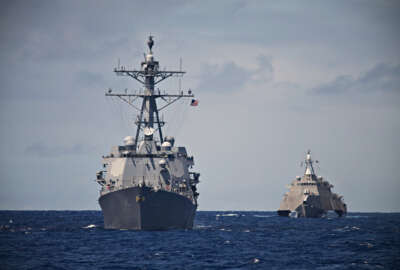DoD Cloud Exchange 2023: USSOCOM’s Mark Taylor on creating a valid cloud-first hybrid strategy
It’s not enough to adopt and blend a variety of cloud presences. The on-premise environments must also behave like the cloud, USSOCOM’s chief technical offi...
The U.S. Special Operations Command maintains headquarters in bustling Tampa, Florida. SOCOM’s kinetic activities occur in much more austere parts of the world. Everyone in the command understands this, and it informs the approaches USSOCOM takes with its activities, including cloud computing.
“When we prosecute war or not war, we’re normally not doing those in Malibu or Times Square or someplace nice,” said Mark Taylor, USSOCOM’s chief technical officer, during Federal News Network’s DoD Cloud Exchange 2023. “We’re normally doing it in some part of the world that’s not necessarily hospitable.”
Broadband communications, for example, may be unavailable in such an environment and therefore so is reach-back to commercial clouds. That’s why USSOCOM pursues a blend of robust cloud capability combined with powerful disconnected, edge computing — all while avoiding the capital expenditures associated with on-premise data center computing.
On a more practical level, Taylor said he’s working to give the command’s activities a choice of commercial clouds. The cloud services providers — those both larger and small — each have desirable if differing qualities, he said.
“The reality of having just one vendor is just not very realistic anymore,” Taylor said. On arrival at USSOCOM almost two years ago, he found several CSPs in use, having occurred organically, without a real strategy. And he noticed varying levels of maturity among the command’s cloud users.
“Once I got here, I made the firm decision to try to provide an enterprise offering,” Taylor said, “or at least corral them to some degree, so that we could offer the different types of clouds at different [security] impact levels.”
He said that way USSOCOM components can consume cloud services through an organized set of contracts “versus half-sanctioned, shadow IT.”
A multicloud, hybrid strategy gives users choice, but it also changes that portion of computing that remains on premise, Taylor said. Specifically, the data center component must meet a new definition of hybrid.
“If you keep saying, ‘We’re hybrid,’ which we are, well, some people are going to hear, ‘Well, that means I’m on premises,’” Taylor said. While some services do remain in physical data centers, those facilities must operate exactly like the cloud, he added.
For consistency in service, “as you buy new gear, you need to make sure you are buying gear that can look and feel just like your cloud experience. That’s the critical difference,” Taylor said.
3 benefits for aligning cloud, on-premise services
This approach to on-premise gear has at least three benefits, Taylor said:
- First, the organization can avoid having to sustain parallel but different computing skillsets. “I can have one skill set,” Taylor said. “I don’t have to have a bunch of server huggers and a bunch of cloud bubbas. I can have one operating force that knows how to work.”
That helps users too. Then everyone has a uniform computing experience, regardless of where they are or what application they are using, he said.
- Second, uniformity enhances the ability to deliver effective compute to austere environments, which is a continual demand for USSOCOM. Taylor described a process of containerizing applications, along with the data and I/O capabilities they need, and loading it all onto a self-contained device warfighters can take into disconnected situations.
“These are some of the things that we have really invested in, continue to invest in,” Taylor said. “We continue to work with our cloud service providers to look at ways to make that easy. So if there’s service X that I like from cloud provider Y, I could then take it as container Z and move forward.”
Plus, when a field device returns to network connectivity, whatever new data or analysis occurred can then sync either with the cloud hosting the original application or with the on-premises computers that look like the cloud.
- Third, there’s quicker value from any capital expenditures USSOCOM does make.
A cloud-first approach means looking at refreshing a traditional data center from the perspective of the full enterprise from the get-go, rather than buying “$5 million worth of stuff and then beginning to figure out how to extract value from that bunch of bare metal,” Taylor said.
Even with the residual need for on-premise investments, real value comes from going all in with cloud, Taylor said.
“Everybody knows about the scale and the flexibility of cloud, relative to an on-prem capability,” he said. Cloud computing is hardly free, but the organization can better match requirements and therefore costs because of the ability to scale up and scale back with computing.
The virtue of the cloud stems from “the fact that I could go to a pre-setup data lake or multimillion-dollar server, put in a question, have it crushed and get that answer in like an hour. But then turn it off when I’m done,” Taylor said.
Uncomfortable comfort
Taylor shared that he’s found that people in USSOCOM possess an above-average ability to tolerate change. And that tolerance extends to the shift to cloud computing, with all of the operational, technical skills and cultural changes that cloud brings.
“The reality is, is we’ve got folks who come from a culture, who during the last 20 years of being at war, are of the mindset of getting comfortable with being uncomfortable,” Taylor said. To a greater degree than most organizations, people in USSOCOM have what he called a bias for action, “a culture of folks that are willing to go and try something.”
The USSOCOM culture tends to rotate uniformed people through jobs and then back to their service. People rarely make a career in one place. “Within Special Operations Command, the doers — not necessarily the communicators — are the ones that are pushing the envelope to try to make sure that they come to us with requirements to provide interesting things. And the reality is, cloud provides that scale and flexibility.”
That people come and go doesn’t dissuade USSOCOM from providing training and certification opportunities to people who may not be in a position for very long.
“A lot of folks say, ‘Well, what if we train them and they leave?’ And then obviously, the savvy CIO would say, ‘Well, what if we don’t train them and they stay?’” Taylor said. “We’ve got a very robust training program and training opportunities that are available to the folks here.”
These trained people may “loiter” for a while, Taylor said, “but sooner or later you will go back to the main force, like Big Air Force or Big Navy.” USSOCOM-trained people become what he called a great advertisement for recruiting people to work in special forces.
“We, USSOCOM, have found great value and great benefit in investing in our people,” Taylor said.
To read or watch other sessions on demand, go to our 2023 DoD Cloud Exchange event page.
Copyright © 2024 Federal News Network. All rights reserved. This website is not intended for users located within the European Economic Area.
Tom Temin is host of the Federal Drive and has been providing insight on federal technology and management issues for more than 30 years.
Follow @tteminWFED
Related Stories
Featured speakers
-

Mark Taylor
Chief Technical Officer, U.S. Special Operations Command
-

Tom Temin
Host, The Federal Drive, Federal News Network
On DoD
Upcoming Events
Related Stories
Top Stories

Mark Taylor
Chief Technical Officer, U.S. Special Operations Command
Dr. Cyril “Mark” Taylor, is an appointed Civilian Senior Executive Highly Qualified Expert (HQE) which is a grade equivalent to the SES. He serves as the Chief Technical Officer, Communications Systems for the United States Special Operations Command (USSOCOM), MacDill Air Force Base, Florida. As CTO, he is responsible for the SOF Information Enterprise (SIE) multi-cloud strategy, engagement with industry, academia, as well as fellow U.S. and international government agencies to identify future-innovative technologies for incubation, cybersecurity compliance, and continuous integration & delivery. Additionally, he supports the optimization of acquisition methods, business process improvement, and human capital management in perpetual service to USSOCOM’s 70,000+ global community.
A native of Baltimore, Maryland, Dr. Taylor was commissioned in the U.S. Army in 1993. He served in various branch qualifying roles as a Field Artillery Officer both in the 25th Infantry Division in Oahu, Hawaii and later the 3rd Infantry Division. Prior to his HQE appointment, Dr. Taylor was a Senior Technology Strategist with Microsoft, supporting the Department of Homeland Security through their Digital Transformation efforts and respective cloud journey. His primary technical background has been focused on federal cloud migration, network and data center design and implementation, as well as technical training to include IT certifications, undergraduate and graduate school.

Tom Temin
Host, The Federal Drive, Federal News Network
Tom Temin has been the host of the Federal Drive since 2006 and has been reporting on technology markets for more than 30 years. Prior to joining Federal News Network, Tom was a long-serving editor-in-chief of Government Computer News and Washington Technology magazines. Tom also contributes a regular column on government information technology.







